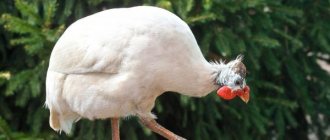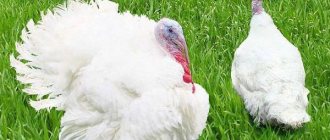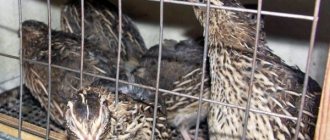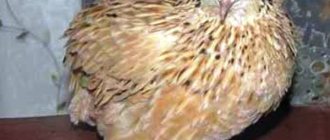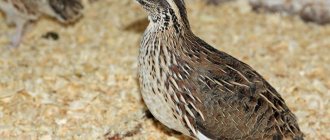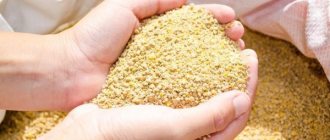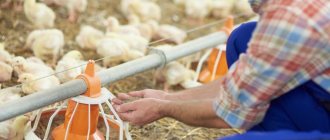How to distinguish quails by gender
You can accurately determine the sex of a quail from about three weeks of age. It is during this period that the plumage of quails rapidly grows and they become sexually mature. Before this age, it is virtually impossible to do this.
Experienced poultry keepers know that female chicks are more active. They move more and make different sounds, thereby causing the breeder a lot of trouble. This is probably the only opportunity to set the sex of the chicks. The male's calmer behavior helps to distinguish him.
According to statistics, out of one hundred eggs laid, about half will hatch into females. If you want to increase this figure in favor of females, then you need the male to be somewhat older than the females and you will have a significant increase in the number of laying hens in the herd.
How to distinguish a female from a male in quails?
If a quail breeder keeps them to obtain eggs, then this is, perhaps, a mandatory skill in order to be able to separate female quails from males on time. Of course, for breeding, you also need to distinguish the sex of the bird, but in this case you need to have time to place the cockerel with the females. In a quail family, there are seven to ten females per male.
As a result of observations, the fact was revealed that out of fifty eggs laid, half will be boys and half will be girls. The probability of a laying hen appearing in a herd is related to the age of the quail. It is necessary that the cockerel is older than the hens. Remember this fact if you need to increase the number of quails.
Determining the sex of adults
After the change of down feathers is completed, the quails can be considered adults and at this time it is much easier to determine their sex, namely where the hen is and where the cockerel is.
Females traditionally have a more variegated color, and if you examine their breasts more closely, you will notice many dark spots.
Female
In males, the plumage on the chest is usually monochromatic.
Male
In addition, quails have more contrasting plumage on their heads than quails. The male's craw and cheeks are lighter than those of the female, and the beak is slightly darker.
How to distinguish a quail from a quail - signs of a male and a female
Quails are kept for various reasons.
Many people want to provide their family with nutritious and tasty foods - meat and eggs are considered very healthy. For some, a small bird is just a decorative pet. But there are also many who build their own business: such farmers start several hundred heads at once in order to later sell the carcasses or sell the eggs. But in any case, the timely formation of a herd is required, and it consists of families: one male and 3-5 females. How to determine the sex of a bird, distinguish a quail from a quail? This is quite possible to learn.
Secretory gland
Sex determination by secretory gland is the most accurate method for determining the sex of these birds. In quails, this gland is poorly developed, making it very difficult to determine their sex.
To establish sex by the secretory gland, you need to take a quail and turn it with its paws up. Next, spread the feathers near the cloaca:
- if the surface is smooth and has a dark pink tint, without noticeable bulges, then with a high degree of probability we can say that this is a female.
- if in the area under study there is a clearly visible growth, this means that you have a male specimen in your hands. If you lightly press on this tubercle, a foamy liquid with a white tint should emerge.
Release of foamy liquid when pressed
Determining the sex of quail at a young age
Before the pets have feathers, there are no external signs for screening. But it is believed that the female half is more fussy and noisy. When the plumage is formed, the differences become obvious. To see them, you need to look at the sternum area.
- Males have a monochromatic pattern.
- Females have variegated feathers (gray, black and white).
The beak of cockerels is darker, and the cheeks and crop, on the contrary, are lighter than those of laying hens. The “cap” on the boys’ heads is of more contrasting shades.
This method is not suitable for so-called “colored” breeds. They have the same color for both sexes: black English, white English, marbled, pharaoh, Texas, etc. For these species you will have to use other methods.
In terms of carcass structure, females are larger, but their body outlines are more proportional; males have a larger head and beak - this trait applies to any breed.
Sex determination in colored breeds
Almost all new quail breeders, when selecting a breed, try to choose one in which it is easy to distinguish a female from a male by appearance, and treat colored breeds with caution and great caution due to little experience and knowledge. This is explained by the fact that in quails with colored plumage, it is almost the same in both males and females. To accurately determine the gender, you need to look “under the tail.” Let's try to figure out how to determine gender regardless of breed.
In breeds such as:
- Estonian;
- Manchurian golden;
- Japanese;
- Pharaoh sex can be determined by the color of the plumage, since the above breeds are as close as possible to the wild color.
An experienced poultry breeder can determine the sex of these breeds even at four weeks of age and even earlier, by the color of the feathers on the breast.
Sex determination by chest plumage
The following characteristics can be distinguished in male quails:
- the color of the feather on the breast is uniform without any dots;
- bright mask on the head;
- The head and beak of males are larger than those of females.
In females:
- the head and beak are graceful and proportional;
- on the breast the color is somewhat blurred, there may be small dots.
Methods for finding differences
You can distinguish between girls and boys in a quail farm using different methods, including:
- Differences by gender. The best time to determine the sex of a bird by the first signs that appear is when it reaches three weeks of age. During this period, birds reach sexual maturity and their final plumage is formed. Until they reach maturity, sex can be determined, but indirectly and far from accurately. For example, a quail is more restless, unlike a male quail, which does not move willingly.
- Determination by color and type of feather. Recognizing a bird by its plumage depends on the selected breed. There are breeds with wild colors, and there are those that are almost impossible to identify by their plumage. At three weeks of age, the bird is completely covered with feathers, and the farmer or breeder can already distinguish the sex of even such chickens. The plumage differs in the chest area and around the eyes: the most variegated plumage is on the breast of females, and the breast is covered with many black spots. The feathers of males, on the contrary, are not so bright and are often monochromatic. In cockerels, contrast in the feathers is observed around the eyes; in hens it is absent. The quail boy has a kind of mask drawn around his eyes. The cheeks and front throat plumage of males are lighter than those of females, but the beak, on the contrary, is darker in males.
- Determination by external signs. Boys are smaller in size and weight than girls, but males have larger beaks and heads. The female quail sex has a more rounded shape, while the stronger half has a more elongated body structure.
- Identification by voice. If the color of a bird does not allow you to determine its gender due to the uniform plumage of the breed, then there is another simple way to differentiate, by its voice. Starting from about a month and a half, females begin to sing. Naturally, their singing is significantly different from the nightingale; it rather resembles a whistle. If we look at the male’s singing, then it’s difficult to call it singing; it’s more like a cry. Moreover, the boy constantly screams, unlike the female. This method makes it easy to separate the birds before feeding; when the pets are hungry, you can hear them very far away.
But it is not always possible to distinguish a male from a female in a quail farm using similar methods. Depending on the breed, age of the bird and the experience of the breeder, incorrect conclusions are possible. There are four breeds with which errors will definitely not occur:
- Manchurian.
- Estonian.
- Japanese.
- Pharaoh.
Video “Determining sex by plumage”
This video shows how to distinguish between a male or female quail in front of us by the color of its plumage.
In colored quail breeds, the sex is slightly different, since their color is almost identical. Although with more careful observation they can be detected, albeit with difficulty. Males from the age of six weeks try to start singing, although it can hardly be called singing, it is more like a scream, which is not at all pleasing to the ear. But the women whistle quietly and quite pleasantly. However, such observation is a rather lengthy process and is not particularly accurate.
Colored breeds:
- black English;
- white English;
- tuxedo;
- marble.
There are a couple of English quails in the photo and they are almost identical, although one of them is male and the other is female, it is difficult to distinguish at first glance and determine where the male is and where the female is.
A couple of white English breeds
It is very difficult to determine sex before six weeks of age, since the secretory gland in quails is hardly noticeable. If anyone doesn’t know where it is, let us tell you that in quails it is located between the cloaca and the base of the tail, in particular, it is precisely this that we need to find or not find to establish sex.
We proceed according to the following scheme.
To determine the sex of a colored quail, you need to take the bird in your left hand as in the photo
The bird must be held in the left hand
Next, you need to turn it over with its belly up, and with your free hand you need to push the feathers at the base of the tail slightly above the cloaca.
Now we can see two options:
in the first case, we may not notice anything except the dark color of the cloaca without tubercles and bulges above the cloaca next to the tail, as in the photo
conclusion one in front of you is a female.
The second option is shown in the following photos
In this case, a growth is clearly visible, which is the secretory gland of the male. If you press it carefully, a whitish secretion may come out. This indicates that this is a male quail.
However, as mentioned above, it is possible to determine the sex of quails based on secondary characteristics:
- head shape;
- singing;
- intensity of color of the mask on the head in males;
- behavior in the herd.
However, the most reliable method is to examine the cloaca in individuals older than forty days.
By applying these recommendations in practice, you can easily distinguish your feathered charges by gender. This is very important when maintaining them. Since females can provide you with testicles for a whole year. And males, having reached a certain age, will become a real decoration of any table.
Individuality of colored quail species
Not so simple
It is much more difficult to determine the sex of quails and quails of colored varieties, since their plumage is the same color. These include the black and white English breed, as well as the Texas breed.
In such cases, attention should be paid to other sexual characteristics. Let's consider how to distinguish quails of the listed species.
English white
A representative of this breed of any gender is recognizable by its snow-white color, sometimes with black dots.
Quails are distinguished from quails by their voice. Boys make sharp, sometimes unpleasant screams. The girls' voice is quiet and melodic.
There are gender differences in the structure of the body. The male looks awkward due to his large head. The female has a proportionally developed body. She is graceful and larger in size.
Black English
In birds of this species of both sexes, black and brown shades predominate in the plumage. They can be distinguished by the structure of the body, as well as by the gonads and pubic bones.
Professional breeders distinguish quails and quails of a given breed by their behavior during a walk, but only when the number of birds is small. With a large number of livestock it is easy to get confused.
The features of the described breeds are disclosed in the article “Black and White English Quails”.
Texas
Females and males of this species also cannot be distinguished by the color of their plumage. And they differ slightly in size, especially during the fattening period.
Therefore, the main way to determine the sex of a Texas quail is to look under the tail and look for the secretory gland. How to do this correctly is described above.
Find more details about this species in the article “Characteristics of Texas Quail.”
How to determine the sex of young quails
Real breeders who raise quails for eggs or meat understand well what a good cause they are doing. After all, any quail product, be it egg or meat, has unique taste and beneficial properties. It is used for baby food as complementary foods, for dietary nutrition, and also in cooking when preparing delicious and beautifully decorated dishes.
If you don't mind the hassle of raising quail chicks, then be prepared for your efforts to pay off. And there will be no problems with sales, since quails are in great demand.
But first you need to start by purchasing quail chicks. How not to make a mistake and buy exactly what you need, you will read in our article.
How to determine the sex of quails
In order to decide on the choice of chicks, let's first summarize all the criteria for choosing quail chicks:
- Firstly, female quails, even at a very early age, already have quite variegated colors. In the chest area already in the second week you can detect dark dots. Males have a more even color of plumage, but the head is more clearly variegated. Males have one more feature: their beak is darker in color than that of females.
- Secondly, when your pets are already 20-21 days old, it will be possible to visually distinguish them by size and weight. Quails begin to grow rapidly and gain weight, and soon become almost a quarter larger than quails.
- Thirdly, you can use the so-called “Japanese method”, which is usually used to select chicken chickens. You need to inspect the chick's cloaca and lightly press from the sides. In males, the tubercle will be clearly palpable and white fluid may be discharged from the cloaca. The chickens should not have a lump or discharge.
- Fourthly, you need to take a closer look at the color of the feathers. Usually, hens have speckled plumage in the breast area, while cockerels, on the contrary, have smooth reddish plumage, without any specks. But there is one caveat. You can clearly see this difference only at three weeks of age.
- Fifthly, quail girls are very loud at an early age. This property disappears with age, but in the first two weeks it makes it possible to distinguish females from males with a probability of 90-95%.
So, we have analyzed the main signs of differences between quails by gender. Now you need to answer the question of why this selection is needed.
When placing quail eggs in an incubator, we always want more hens to hatch when they hatch, since hens lay precious eggs that are always in demand. But, as a rule, the ratio of hens and cockerels is always 50 to 50. That is, half of the brood will definitely be hens, and the second half will inevitably be cockerels.
There is a little secret on how to increase the number of eggs from which females are guaranteed to emerge.
To do this, you need to add an older male to the quails.
In addition, it should be borne in mind that quails are very sensitive to mating with related individuals. Therefore, it is advisable to introduce males from other broods or from other breeders into the herd. If you do have a related cockerel, do not be surprised that the egg production of your quails will be an order of magnitude lower.
When the cockerel is younger than the hens, more males will be produced.
Accordingly, in the case of the same age of the male and female, both males and females will emerge from the eggs equally.
If the selection is made correctly, you can send extra males for fattening, and the selected strong individuals can be placed with hens for procreation.
How many male quails are needed for farming?
In order for quails to lay eggs well and lay fertilized eggs, they need males that normally fertilize females.
Based on practice, it is believed that for five females one male is enough. Therefore, when choosing chickens, do not rush to get rid of the males. You need to have a certain number of replacement cockerels. You never know what can happen to the male. So that the hens do not remain unattended, it will be necessary to immediately place another male with them.
In addition, an excess number of males can always be used for meat. Some breeders specifically try to fatten the males better in order to get a higher quality product.
Quail content
These birds have recently become especially popular among lovers of gourmet eggs and meat. Since their content does not require any special knowledge, anyone can cope with this task.
One of the advantages is that the birds do not need additional walking. They can live in an ordinary cage. The most important thing is to provide the birds with adequate lighting and ventilation. On an area of 6 squares you can grow about 400-500 quails.
Go for it! You will succeed!
Related posts:
- Sex determination in goslings
- Determining the sex of ducklings
- Determining the sex of chickens
- Diseases will quail
Recently, quails have been bred everywhere. This is done by both farmers and beginners, since many people know about the benefits that come from breeding this bird. But every owner needs to be able to determine the sex of quails. This is especially true for those who breed quails to obtain eggs, for example, for the purpose of selling them (in such a situation, more females are needed). Now we will talk about how to distinguish a female quail from a male in order to form the right flock.
Determination by male courtship
You can, of course, distinguish a male from a female in a more natural way, but it is not entirely convenient. When males acquire the ability to mate, the chukar begins to differ from the hen in its behavior; the boys are more active and often “show off” in front of the opposite sex, trying to show their dominance.
But observing the entire quail family in order to identify the male during the mating process takes a lot of time, and making the right choice when the bird is in a cage in large numbers is not very practical. In addition, if the hen does not agree to the cockerel, then she will be aggressive with him and even pugnacious throughout the courtship. In this case, it is better to place such a pair in different cells.
About
At what age can you determine the sex of a rabbit?
In adult animals, sex is determined quite easily, since the reproductive organs are already fully formed and have pronounced differences. But the younger the rabbit, the more difficult it will be to distinguish a female from a male.
Experienced rabbit breeders can distinguish between baby rabbits starting from 1 month of age, but an untrained person is unlikely to be able to do this correctly. But when the babies grow up, for example, to 2 months, or better yet to 3, then at that age it will become much easier to determine the sex of the rabbits.
Determination of gender
You can find out the gender of a rabbit in 2 ways: by the appearance of the external reproductive organs, their characteristic differences, as well as by the characteristic behavior of animals, which dictates their gender.
According to primary sexual characteristics
With great accuracy, animals are distinguished by their external reproductive organs. This is the most accurate method of determination and usually gives error-free results.
To do this, they need to be examined as follows:
- Take the animal by the withers with one hand, lift it, turn it over on its back so that it reclines with its paws up. The rabbit feels comfortable in this position and it is quite safe for humans.
- Without releasing the withers, pinch the tail with two fingers of the other hand, and with your thumb pull the skin towards the head. In this form, the genitals of animals become clearly visible and can be easily seen.
In small male rabbits, a round hole will be noticeable, located far from the anus; in older male rabbits, the genital organ looks like a tube. The females' organs are located closer to the anus and resemble an elongated slit, tapering towards the tail.
Baby rabbits
At 1 month, it is extremely problematic to determine with accuracy who is who: male or female, the rabbits are still too small, all their primary sexual characteristics are very weakly expressed.
This is why rabbit breeders who want, for example, to sell their babies faster, often make mistakes. At this time, the only way to distinguish a boy from a girl is this: you need to compare the distance from the genitals to the anus. In male rabbits it is always slightly larger than in their female counterparts.
At 2 months the same method works, but now you can distinguish a rabbit from a female rabbit with greater accuracy. And finally, when animals reach 3 months and become sexually mature, their organs acquire characteristic, pronounced differences. It is at this age that it is necessary to place rabbits, as they begin to sort things out and are already able to reproduce.
Although animals can be boarded earlier - at 2 or 1.5 months. Some breeders wean babies even at 1 month, but this, according to most veterinarians, is still too early: baby rabbits should be with their mother for at least 2 months, so they get sick less, grow better, and are stronger physically and mentally. It is advisable to place the rabbits one at a time or, in extreme cases, 2-3 each.
Adults
Once the animals are grown, it will be easiest to determine their sex:
- In females, almost next to the anus, a pink “loop” will be visible.
- In males, a little further from the anus there will be a slightly curved small process.
In addition, you can distinguish an adult rabbit from a female rabbit by the presence of testicles. They are located below the genital organ on both sides and look like small swellings covered with sparse fur. However, the testicles are not always visible, as rabbits may retract them into their body if they are very frightened.
By secondary sexual characteristics: appearance and behavior
Female and male adults have, although not pronounced, still distinctive morphological characteristics and often behave differently in certain situations. These differences will also serve as additional criteria for determining sex in domestic rabbits. But they do not provide a guaranteed result, so you should not rely on them alone.
Samtsov
They are usually larger than females of the same age, they have slightly angular body shapes, a larger, more massive head, a wider chest, larger paws, and coarser fur.
Male rabbits always behave more actively, aggressively, often fight among themselves, and can attack new animals that have just been placed with them.
Females
The body of females is smaller, rounder than that of males, the skeleton is lighter, the head is smaller, elongated, wider than the croup, the fur is thinner, more delicate, 2 rows of nipples can be felt on the stomach.
The behavior of female rabbits is calmer; they fight among themselves only if kept in large groups. They do this in order to establish hierarchical relationships.
Features of determining the sex of decorative breeds of rabbits
In determining the sex of a dwarf rabbit, the same rules apply as for farm animals. In them, the male differs from the female in the same way as in representatives of the meat and down breeds, because these are the same species of animals.
You just need to be more careful, since decorative dwarf rabbits are smaller in size, and accordingly, all their organs are also smaller.
Bird behavior
In backyards, quails are often kept together. To distinguish a male, you can observe his behavior in the herd. Hens are more active than cockerels.
A place convenient for laying is allocated for laying hens. This should be a quiet corner in the house or pen. Boxes with hay are installed for chickens. Egg dummies are placed in them so that the birds can determine where to lay eggs. If the hen does not see the nest, she will make it herself, but the poultry farmer will have to look for the place where the quail laid the eggs, which can be difficult.
During puberty, quails begin to develop the reproductive instinct. The cockerels take care of the hens. Quails are polygamous individuals. 1 male can care for 4-5 females. How to distinguish a quail from a quail:
| № | Helpful information |
| 1 | males circle around females, trying to attract attention |
| 2 | they give voice. The chicks are distinguished by a loud whistle, but at 3-4 weeks the males begin to trill. The voice of females is dull, a bit like a loud whisper |
| 3 | the cockerels try to climb onto the hens, holding onto her crest with their beaks; therefore, females may develop bald patches in the collar area |
More on the topic: How to make a quail cage from plastic boxes?
The quails are starting to prepare for their first clutch. They move actively, but can suddenly sit down and remain in this position for a long time.
Igor Nikolaev
auto RU
Especially the change in behavior in females changes noticeably after mating. They begin to look for a place to nest. It is necessary to prepare for this period.
How to recognize a male by behavior
If the livestock is kept not in cages, but in an aviary, you can try the observation method.
During walking, representatives of different sexes behave differently. Males will attempt mating. At the same time, they catch their passion with their beak by the plumage on the head and pull it to the side or towards themselves. Then the boyfriend presses his whole body closely to the lady. But this method can only be recommended to experienced poultry farmers. For beginners, at first the movement of individuals around the yard will seem spontaneous. In addition, this bird is quite fussy. Small conflicts are also possible, causing complete chaos in the herd. And the entire mating process takes literally a few seconds.
By physique
You can distinguish a male quail from a female by the structure of the birds' body. Professional poultry farmers identify several main signs that will help distinguish birds:
- Quails have a disproportion in their body. Quails are folded harmoniously and proportionally.
- Males have an elongated neck and an oblong chest.
- Females are always larger. They weigh more.
- The structure of the bones in the paw area is also different. In chickens, the pelvis expands, forming a fork. In cockerels, the pelvic bones have an almost parallel structure. It is necessary to pay attention to the structure of the skeleton only after birds reach two months of age, since in an earlier period the bone structure of birds is practically no different.
The method of determining sex by the body structure of birds is recommended to be used in combination with other options, since it is sometimes difficult to assess the proportionality of the body by eye.
Indian ducks and their main differences
Only at first glance it may seem that females and males are no different. But that's not true. For example, drakes have bright colored feathers, while inducks have gray feathers. Moreover, they have a beard, and in females it is almost invisible. There are also other signs that make it possible to determine the sex of a bird:
- Females have straight tails, while drakes have rounded feathers.
- A long neck and a fairly wide body are what distinguish males from Indian ducks.
- Voice is another sign by which you can find out the sex of birds. Females quack more, but drakes make hissing or whistling sounds.
- Drakes, as a rule, let females pass during the period.
Of course, almost all breeders strive to find out the sex by sex. The presence of a pseudopenis is proof that this is a drake. To detect it, it is recommended to massage the edge of the cloaca.
Basic moments
How to distinguish quails by their gender? Talking about how to distinguish a female from a male in quails, first of all, it should be noted that the solution to such a problem seems possible when these birds reach three weeks of age (or even much later, depending on the breed). True, some breeders insist that small female quails are more active than boys. According to such poultry farmers, girls squeak more often and louder, while boys in the early stages of development are distinguished by a calm character. Otherwise, determining the sex of chicks, as mentioned above, is extremely difficult due to the lack of characteristic sex differences in babies.
It is also reasonable to add that when quails are approximately 3 weeks old, they begin to show significant differences in the rate of development. It has been noticed that, having reached this age, females begin to grow much faster than males, becoming noticeably more massive after about 15 days. In such cases, distinguishing birds by gender is not particularly difficult, which is regularly confirmed in practice.
In addition, despite the inability to clearly determine the sex of quails whose age is too young, this problem can be solved approximately. Many breeders believe that if young females and older males are mated, the total number of girls born will significantly exceed the standard 50%. Of course, this method does not allow determining the sex of each individual individual, but with its help you can get a general idea of the gender structure of the maturing generation.
How to determine the sex of Indian ducks?
There are a lot of differences that allow you to find out the sex of a bird. Although it is more difficult to distinguish ducklings than adults, it is still possible. So many poultry farmers first of all pay attention to external signs. In the photo you can also see what male and female individuals look like. Here are the main differences between Indo ducks:
- The body weight of drakes is much higher than that of females, and is about 6 kg, while the weight of ducks is up to 3 kg.
- Drakes have a more cocky disposition, while Indian ducks are very calm and peaceful.
- The plumage of females is quite modest in comparison with males.
- The presence of a red, rough fold of skin is evidence that this is a drake, and in females it is softer and lighter.
- Indian ducks have a more graceful neck curve and not very massive muscles.
If you take a closer look at poultry, every breeder will certainly notice these and other differences. When you can accurately determine the sex of an Indian duck, feel free to go to the market to buy Indian ducks, which are raised by farmers for meat.
